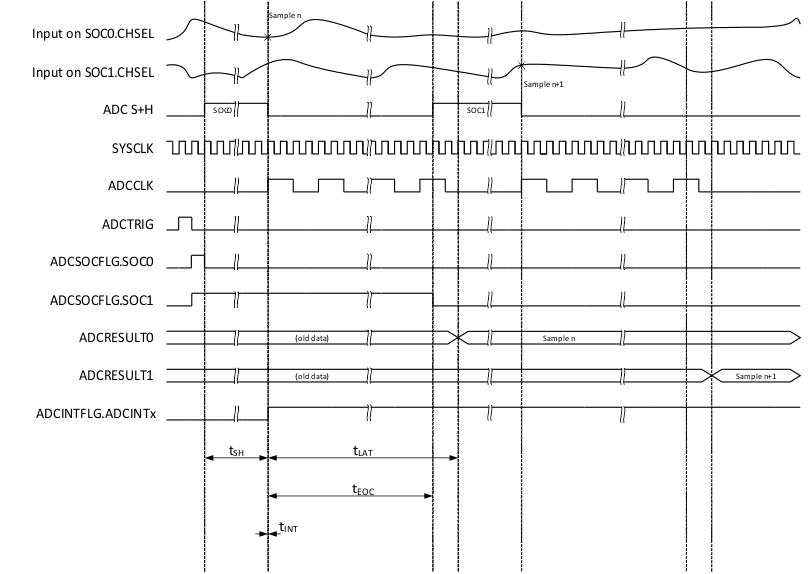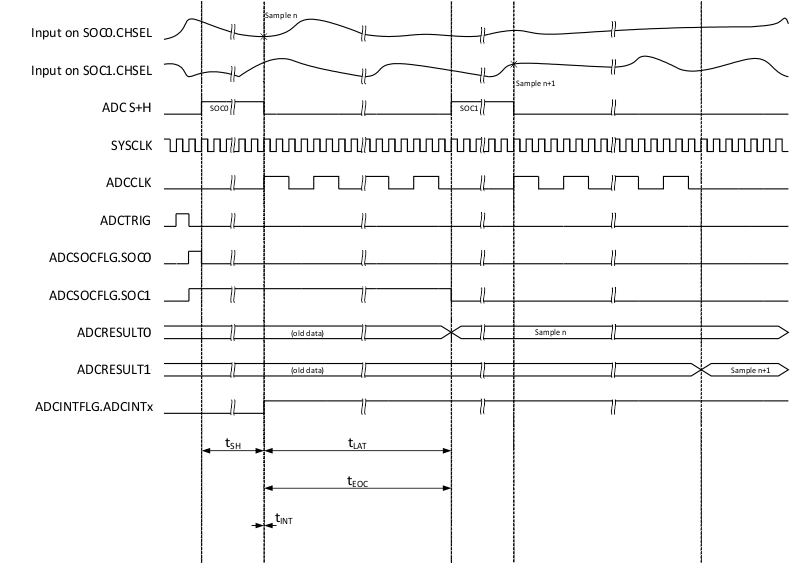SPRSP93 November 2024 F29H850TU , F29H859TU-Q1
ADVANCE INFORMATION
- 1
- 1 Features
- 2 Applications
- 3 Description
- 4 Device Comparison
- 5 Pin Configuration and Functions
-
6 Specifications
- 6.1 Absolute Maximum Ratings
- 6.2 F29H85x ESD Ratings – Commercial
- 6.3 F29H85x ESD Ratings – Automotive
- 6.4 F29P58x ESD Ratings – Commercial
- 6.5 F29P58x ESD Ratings – Automotive
- 6.6 Recommended Operating Conditions
- 6.7 Power Consumption Summary
- 6.8 Electrical Characteristics
- 6.9 Thermal Resistance Characteristics for ZEX Package
- 6.10 Thermal Resistance Characteristics for PTS Package
- 6.11 Thermal Resistance Characteristics for RFS Package
- 6.12 Thermal Resistance Characteristics for PZS Package
- 6.13 Thermal Design Considerations
- 6.14
System
- 6.14.1
Power Management Module (PMM)
- 6.14.1.1 Introduction
- 6.14.1.2 Overview
- 6.14.1.3 External Components
- 6.14.1.4 Power Sequencing
- 6.14.1.5 Power Management Module Electrical Data and Timing
- 6.14.2 Reset Timing
- 6.14.3
Clock Specifications
- 6.14.3.1 Clock Sources
- 6.14.3.2
Clock Frequencies, Requirements, and Characteristics
- 6.14.3.2.1
Input Clock Frequency and Timing
Requirements, PLL Lock Times
- 6.14.3.2.1.1 Input Clock Frequency
- 6.14.3.2.1.2 XTAL Oscillator Characteristics
- 6.14.3.2.1.3 X1 Input Level Characteristics When Using an External Clock Source Not a Crystal
- 6.14.3.2.1.4 X1 Timing Requirements
- 6.14.3.2.1.5 AUXCLKIN Timing Requirements
- 6.14.3.2.1.6 APLL Characteristics
- 6.14.3.2.1.7 XCLKOUT Switching Characteristics PLL Bypassed or Enabled
- 6.14.3.2.1
Input Clock Frequency and Timing
Requirements, PLL Lock Times
- 6.14.3.3 Input Clocks
- 6.14.3.4 XTAL Oscillator
- 6.14.3.5 Internal Oscillators
- 6.14.4 Flash Parameters
- 6.14.5 Memory Subsystem (MEMSS)
- 6.14.6 Debug/JTAG
- 6.14.7 GPIO Electrical Data and Timing
- 6.14.8 Real-Time Direct Memory Access (RTDMA)
- 6.14.9 Low-Power Modes
- 6.14.10
External Memory Interface (EMIF)
- 6.14.10.1 Asynchronous Memory Support
- 6.14.10.2 Synchronous DRAM Support
- 6.14.10.3
EMIF Electrical Data and Timing
- 6.14.10.3.1 EMIF Synchronous Memory Timing Requirements
- 6.14.10.3.2 EMIF Synchronous Memory Switching Characteristics
- 6.14.10.3.3 EMIF Synchronous Memory Timing Diagrams
- 6.14.10.3.4 EMIF Asynchronous Memory Timing Requirements
- 6.14.10.3.5 EMIF Asynchronous Memory Switching Characteristics
- 6.14.10.3.6 EMIF Asynchronous Memory Timing Diagrams
- 6.14.1
Power Management Module (PMM)
- 6.15
C29x Analog Peripherals
- 6.15.1 Analog Subsystem
- 6.15.2
Analog-to-Digital Converter (ADC)
- 6.15.2.1 ADC Configurability
- 6.15.2.2
ADC Electrical Data and Timing
- 6.15.2.2.1 ADC Operating Conditions 12-bit Single-Ended
- 6.15.2.2.2 ADC Operating Conditions 12-bit Differential
- 6.15.2.2.3 ADC Operating Conditions 16-bit Single-Ended
- 6.15.2.2.4 ADC Operating Conditions 16-bit Differential
- 6.15.2.2.5 ADC Timing Requirements
- 6.15.2.2.6 ADC Characteristics 12-bit Single-Ended
- 6.15.2.2.7 ADC Characteristics 12-bit Differential
- 6.15.2.2.8 ADC Characteristics 16-bit Single-Ended
- 6.15.2.2.9 ADC Characteristics 16-bit Differential
- 6.15.2.2.10 ADC INL and DNL
- 6.15.2.2.11 ADC Input Model Models
- 6.15.2.2.12 ADC Timing Diagrams
- 6.15.3 Temperature Sensor
- 6.15.4 Comparator Subsystem (CMPSS)
- 6.15.5 Buffered Digital-to-Analog Converter (DAC)
- 6.16
C29x Control Peripherals
- 6.16.1 Enhanced Capture (eCAP)
- 6.16.2 High-Resolution Capture (HRCAP)
- 6.16.3 Enhanced Pulse Width Modulator (ePWM)
- 6.16.4 External ADC Start-of-Conversion Electrical Data and Timing
- 6.16.5 High-Resolution Pulse Width Modulator (HRPWM)
- 6.16.6 Enhanced Quadrature Encoder Pulse (eQEP)
- 6.16.7 Sigma-Delta Filter Module (SDFM)
- 6.17
C29x Communications Peripherals
- 6.17.1 Modular Controller Area Network (MCAN)
- 6.17.2 Fast Serial Interface (FSI)
- 6.17.3 Inter-Integrated Circuit (I2C)
- 6.17.4 Power Management Bus (PMBus) Interface
- 6.17.5 Serial Peripheral Interface (SPI)
- 6.17.6 Single Edge Nibble Transmission (SENT)
- 6.17.7 Local Interconnect Network (LIN)
- 6.17.8 EtherCAT SubordinateDevice Controller (ESC)
- 6.17.9 Universal Asynchronous Receiver-Transmitter (UART)
-
7 Detailed Description
- 7.1 Overview
- 7.2 Functional Block Diagram
- 7.3 Error Signaling Module (ESM_C29)
- 7.4 Error Aggregator
- 7.5
Memory
- 7.5.1 C29x Memory Map
- 7.5.2
Flash Memory Map
- 7.5.2.1 Flash MAIN Region Address Map (F29H85x, 4MB)
- 7.5.2.2 Flash MAIN Region Address Map (F29H85x, 2MB)
- 7.5.2.3 Flash MAIN Region Address Map (F29P58x, 4MB)
- 7.5.2.4 Flash MAIN Region Address Map (F29P58x, 2MB)
- 7.5.2.5 Flash MAIN Region Address MAP (F29P58x, 1MB)
- 7.5.2.6 Flash Data Bank Address Map
- 7.5.2.7 Flash BANKMGMT Region Address Map
- 7.5.2.8 Flash SECCFG Region Address Map
- 7.5.3 Peripheral Registers Memory Map
- 7.6 Identification
- 7.7 Boot ROM
- 7.8 Security Modules and Cryptographic Accelerators
- 7.9
C29x Subsystem
- 7.9.1 C29 CPU Architecture
- 7.9.2 Peripheral Interrupt Priority and Expansion (PIPE)
- 7.9.3 Data Logging and Trace (DLT)
- 7.9.4 Waveform Analyzer Diagnostics (WADI)
- 7.9.5 Embedded Real-Time Analysis and Diagnostic (ERAD)
- 7.9.6 Inter-Processor Communications (IPC)
- 7.9.7 Watchdog
- 7.9.8 Dual-Clock Comparator (DCC)
- 7.9.9 Configurable Logic Block (CLB)
- 7.10 Lockstep Compare Module (LCM)
- 8 Applications, Implementation, and Layout
- 9 Device and Documentation Support
- 10Revision History
- 11Mechanical, Packaging, and Orderable Information
Package Options
Refer to the PDF data sheet for device specific package drawings
Mechanical Data (Package|Pins)
- PZS|100
- PTS|176
- RFS|144
- ZEX|256
Thermal pad, mechanical data (Package|Pins)
Orderable Information
6.15.2.2.12 ADC Timing Diagrams
The following diagrams show the ADC conversion timings for two SOCs given the following assumptions:
- SOC0 and SOC1 are configured to use the same trigger.
- No other SOCs are converting or pending when the trigger occurs.
- The round-robin pointer is in a state that causes SOC0 to convert first.
- ADCINTSEL is configured to set an ADCINT flag upon end of conversion for SOC0 (whether this flag propagates through to the CPU to cause an interrupt is determined by the configurations in the interrupt controller).
Table 6-21 lists the descriptions of the ADC timing parameters. Table 6-22 and Table 6-23 list the ADC timings.
 Figure 6-40 ADC Timings for 12-bit Mode in
Early Interrupt Mode
Figure 6-40 ADC Timings for 12-bit Mode in
Early Interrupt Mode Figure 6-41 ADC Timings for 12-bit Mode in
Late Interrupt Mode
Figure 6-41 ADC Timings for 12-bit Mode in
Late Interrupt Mode Figure 6-42 ADC Timings for 16-bit Mode in
Early Interrupt Mode
Figure 6-42 ADC Timings for 16-bit Mode in
Early Interrupt Mode Figure 6-43 ADC Timings for 16-bit Mode in
Late Interrupt Mode (SYSCLK Cycles)
Figure 6-43 ADC Timings for 16-bit Mode in
Late Interrupt Mode (SYSCLK Cycles)Table 6-21 ADC Timing Parameter
Descriptions
| PARAMETER | DESCRIPTION |
|---|---|
| tSH | The duration of the S+H window. |
| At the end of this window, the value on the S+H capacitor becomes the voltage to be converted into a digital value. The duration is given by (ACQPS + 1) SYSCLK cycles. ACQPS can be configured individually for each SOC, so tSH is not necessarily the same for different SOCs. | |
| Note: The value on the S+H capacitor is captured approximately 5 ns before the end of the S+H window regardless of device clock settings. | |
| tLAT | The time from the end of the S+H window until the ADC results latch in the ADCRESULTx register. |
| If the ADCRESULTx register is read before this time, the previous conversion results are returned. | |
| tEOC | The time from the end of the S+H window until the S+H window for the next ADC conversion can begin. The subsequent sample can start before the conversion results are latched. In 16-bit mode, this coincides with the latching of the conversion results, while in 12-bit mode, the subsequent sample can start before the conversion results are latched. |
| tINT | The time from the end of the S+H window until an ADCINT flag is set (if configured). |
| If the INTPULSEPOS bit in the ADCCTL1 register is set, tINT coincides with the end of conversion (EOC) signal. | |
| If the INTPULSEPOS bit is 0, tINT coincides with the end of the S+H window. If tINT triggers a read of the ADC result register (by triggering an ISR that reads the result), care must be taken to make sure the read occurs after the results latch (otherwise, the previous results are read). | |
| tDMA | The time from the end of the S+H window until a DMA read of the ADC conversion result is triggered, when ADCCTL1.TDMAEN = 1. |
| If TDMAEN is set to 0, then the DMA trigger occurs at TINT. In certain conditions, the ADCINT flag can be set before the ADCRESULT value is latched. To make sure that the DMA read occurs after the ADCRESULT value has been latched, write 1 to ADCCTL1.TDMAEN to enable DMA timings. |
Table 6-22 ADC Timings in 12-bit
Mode
| ADCCLK Prescale | SYSCLK Cycles | |||||
|---|---|---|---|---|---|---|
| ADCCTL2. PRESCALE | Prescale Ratio | tEOC | tLAT | tINT
(Early)(1) |
tINT (Late) |
tDMA |
| 0 | 1 | 11 | 13 | 0 | 11 | 13 |
| 2 | 2 | 21 | 23 | 0 | 21 | 23 |
| 3 | 2.5 | 26 | 28 | 0 | 26 | 28 |
| 4 | 3 | 31 | 34 | 0 | 31 | 34 |
| 5 | 3.5 | 36 | 39 | 0 | 36 | 39 |
| 6 | 4 | 41 | 44 | 0 | 41 | 44 |
| 7 | 4.5 | 46 | 49 | 0 | 46 | 49 |
| 8 | 5 | 51 | 55 | 0 | 51 | 55 |
| 9 | 5.5 | 56 | 60 | 0 | 56 | 60 |
| 10 | 6 | 61 | 65 | 0 | 61 | 65 |
| 11 | 6.5 | 66 | 70 | 0 | 66 | 70 |
| 12 | 7 | 71 | 76 | 0 | 71 | 76 |
| 13 | 7.5 | 76 | 81 | 0 | 76 | 81 |
| 14 | 8 | 81 | 86 | 0 | 81 | 86 |
| 15 | 8.5 | 86 | 91 | 0 | 86 | 91 |
(1) By default, tINT occurs one SYSCLK cycle after the S+H window if
INTPULSEPOS is 0. This can be changed by writing to the OFFSET field in the
ADCINTCYCLE register.
Table 6-23 ADC Timings in 16-bit
Mode
| ADCCLK Prescale | SYSCLK Cycles | |||||
|---|---|---|---|---|---|---|
| ADCCTL2. PRESCALE | Prescale Ratio | tEOC | tLAT | tINT (Early)(1) |
tINT (Late) |
tDMA |
| 0 | 1 | 31 | 32 | 0 | 31 | 32 |
| 2 | 2 | 60 | 61 | 0 | 60 | 61 |
| 3 | 2.5 | 75 | 75 | 0 | 75 | 75 |
| 4 | 3 | 90 | 91 | 0 | 90 | 91 |
| 5 | 3.5 | 104 | 106 | 0 | 104 | 106 |
| 6 | 4 | 119 | 120 | 0 | 119 | 120 |
| 7 | 4.5 | 134 | 134 | 0 | 134 | 134 |
| 8 | 5 | 149 | 150 | 0 | 149 | 150 |
| 9 | 5.5 | 163 | 165 | 0 | 163 | 165 |
| 10 | 6 | 178 | 179 | 0 | 178 | 179 |
| 11 | 6.5 | 193 | 193 | 0 | 193 | 193 |
| 12 | 7 | 208 | 209 | 0 | 208 | 209 |
| 13 | 7.5 | 222 | 224 | 0 | 222 | 224 |
| 14 | 8 | 237 | 238 | 0 | 237 | 238 |
| 15 | 8.5 | 252 | 252 | 0 | 252 | 252 |
(1) By default, tINT occurs one SYSCLK cycle after the S+H window if
INTPULSEPOS is 0. This can be changed by writing to the OFFSET field in the
ADCINTCYCLE register.